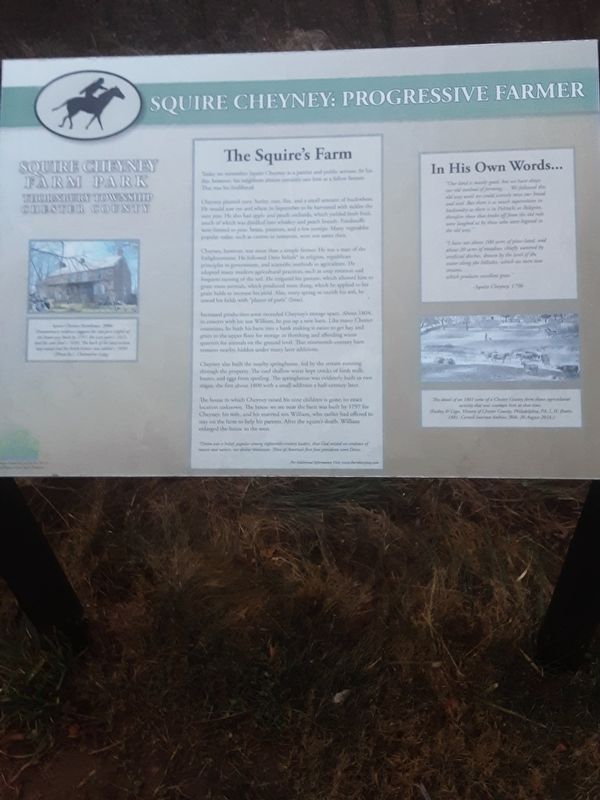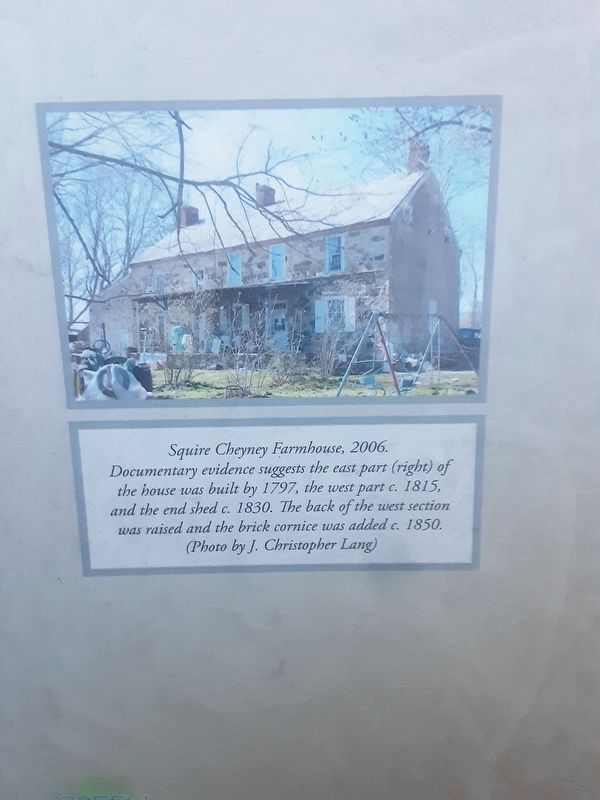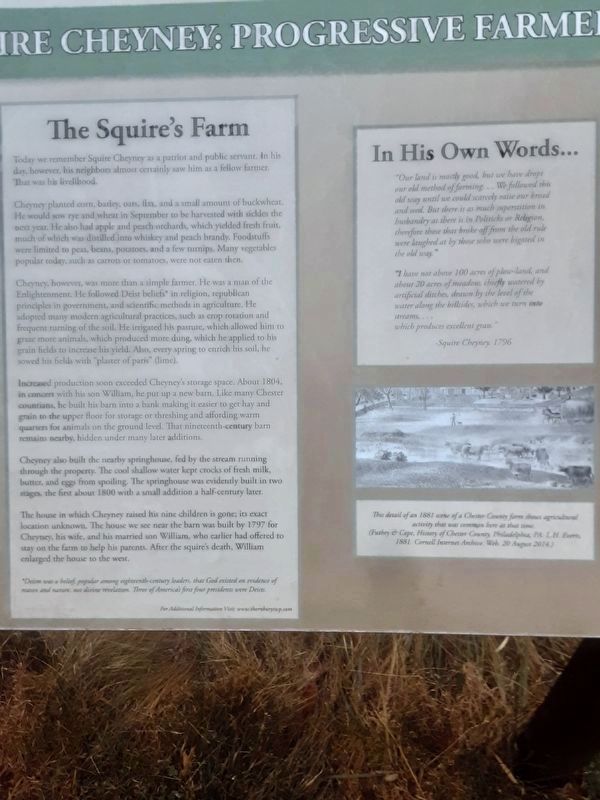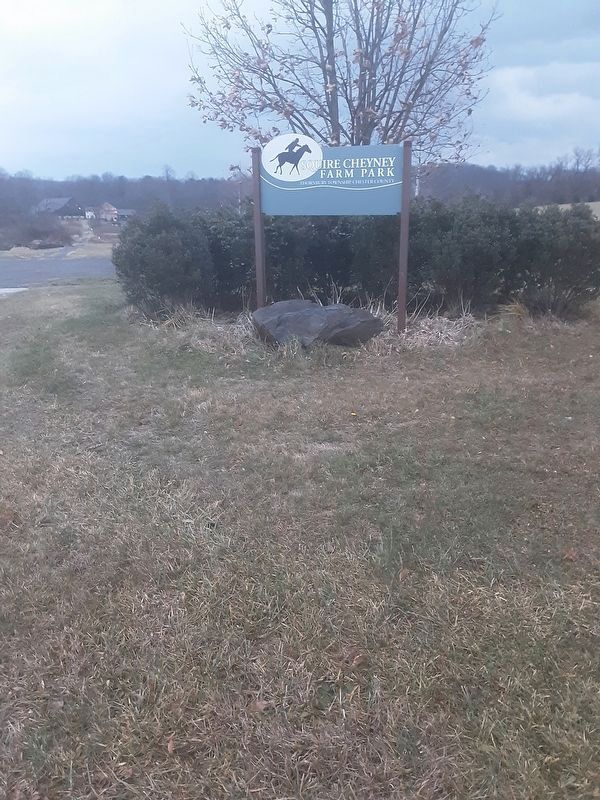Near Glen Mills in Chester County, Pennsylvania — The American Northeast (Mid-Atlantic)
Squire Cheyney: Progressive Farmer
Squire Cheyney Farm Park
— Thornbury Township —
Inscription.
Documentary evidence suggests the east part (right) of
the house was built by 1797, the west part c. 1815,
and the end shed c. 1830. The back of the west section
was raised and the brick cornice was added c. 1850.
(Photo by J. Christopher Lang)
The Squire's Farm
Today we remember Squire Cheyney as a patriot and public servant. In his day, however, his neighbors almost certainly saw him as a fellow farmer. That was his livelihood.
Cheyney planted corn, barley, oats, flax, and a small amount of buckwheat. He would sow rye and wheat in September to be harvested with sickles the next year. He also had apple and peach orchards, which yielded fresh fruit, much of which was distilled into whiskey and peach brandy. Foodstuffs were limited to peas, beans, potatoes, and a few turnips. Many vegetables popular today, such as carrots or tomatoes, were not eaten then.
Cheyney, however, was more than a simple farmer. He was a man of the Enlightenment. He followed Deist beliefs* in religion, republican principles in government, and scientific methods in agriculture. He adopted many modern agricultural practices, such as crop rotation and frequent turning of the soil. He irrigated his pasture, which allowed him to graze more animals, which produced more dung, which he applied to his grain fields to increase his yield. Also, every spring to enrich his soil, he sowed his fields with "plaster of paris” (lime).
Increased production soon exceeded Cheyney's storage space. About 1804, in concert with his son William, he put up a new barn. Like many Chester countians, he built his barn into a bank making it easier to get hay and grain to the upper floor for storage or threshing and affording warm quarters for animals on the ground level. That nineteenth-century barn remains nearby, hidden under many later additions.
Cheyney also built the nearby springhouse, fed by the stream running through the property. The cool shallow water kept crocks of fresh milk, butter, and eggs from spoiling. The springhouse was evidently built in two stages, the first about 1800 with a small addition a half-century later.
The house in which Cheyney raised his nine children is gone; its exact location unknown. The house we see near the barn was built by 1797 for Cheyney, his wife, and his married son William, who earlier had offered to stay on the farm to help his parents. After the squire's death, William enlarged the house to the west.
*Deism was a belief, popular among eighteenth-century leaders, that God existed on evidence of man and nature, not divine
revelation. Three of America's first four presidents were Deists.
For Additional Information Visit: www.thornburytwp.com
In His Own Words...
"Our land is mostly good, but we have dropt our old method of farming... We followed this old way until we.could scarcely raise our bread and seed. But there is as much superstition in husbandry as there is in Politicks or Religion, therefore those that broke off from the old rule were laughed at by those who were bigoted in the old way."
"I have not above 100 acres of plow-land, and about 20 acres of meadow, chiefly watered by artificial ditches, drawn by the level of the water along the hillsides, which we turn into streams,...
which produces excellent grass.
-Squire Cheyney, 1796
activity that was common here at that time.
(Futhey & Cope, History of Chester County, Philadelphia, PA: L.H. Everts,
1881. Cornell Internet Archive. Web. 20 August 2014.)
[at lower left corner of plaque]
Region
The PECO Open Space Program
This project funded in part by the PECO
Green Region Open Space Program
Topics. This historical marker is listed in this topic list: Notable Buildings. A significant historical year for this entry is 1797.
Location.
39° 56.333′ N, 75° 31.32′ W. Marker is near Glen Mills, Pennsylvania, in Chester County. Marker is on Freedom Rider Trail, on the left when traveling south. Touch for map. Marker is at or near this postal address: 154 Freedom Rider Trail, West Chester PA 19382, United States of America. Touch for directions.
Other nearby markers. At least 8 other markers are within 2 miles of this marker, measured as the crow flies. Historic Agricultural Landscape: Preserved for the Public Good (about 400 feet away, measured in a direct line); Squire Cheyney: Public Servant (about 700 feet away); Thornbury Township: Divided Since 1789 (approx. ¼ mile away); Squire Thomas Cheyney (approx. 0.3 miles away); Fanny M. Jackson Coppin (approx. half a mile away); Jimmy Carter (approx. half a mile away); Thornbury: Past, Present, Future (approx. 1.9 miles away); An Era of Community (approx. 1.9 miles away). Touch for a list and map of all markers in Glen Mills.
More about this marker. There are 4 plaques in this park which were submitted to hmdb.org , encountered in the following order when traveling the path counterclockwise (subject plaque listed 3rd):
Thornbury Township: Divided Since 1789
Squire Cheyney: Public Servant
Squire Cheyney: Progressive Farmer
Historic Agricultural Landscape: Preserved for the Public Good
Credits. This page was last revised on April 5, 2022. It was originally submitted on December 17, 2021, by Carl Gordon Moore Jr. of North East, Maryland. This page has been viewed 152 times since then and 34 times this year. Photos: 1. submitted on December 17, 2021, by Carl Gordon Moore Jr. of North East, Maryland. 2. submitted on December 28, 2021, by Carl Gordon Moore Jr. of North East, Maryland. 3, 4. submitted on December 17, 2021, by Carl Gordon Moore Jr. of North East, Maryland. • Bill Pfingsten was the editor who published this page.



